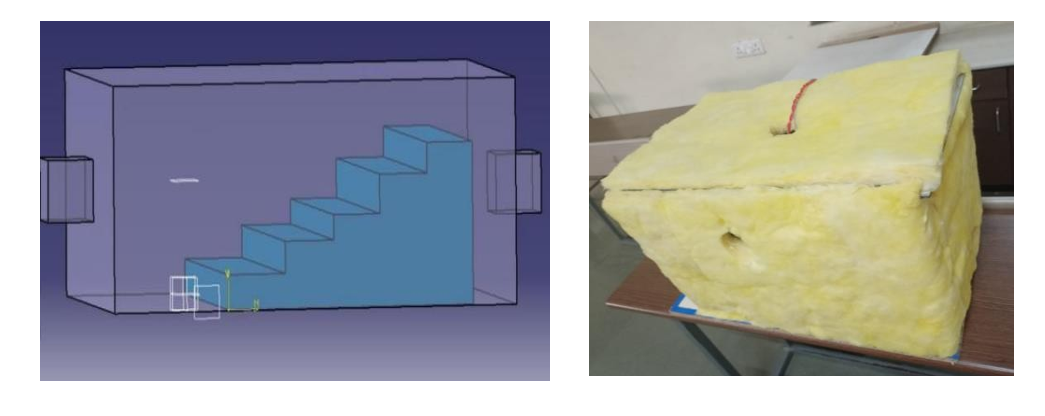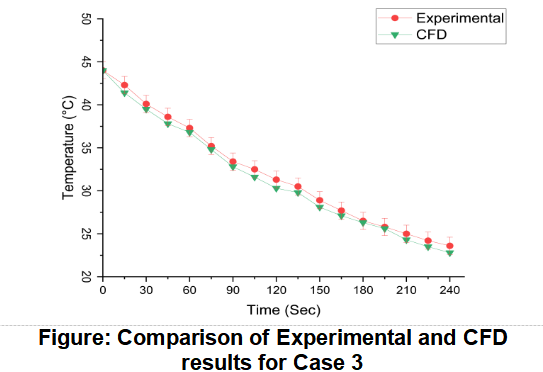
CFD Analysis and Experimental Validation for Optimal Cooling System Position in Theatres
This analysis is focused on optimization and determination of improved locations for air conditioning systems within theatre environments. By examining various factors such as airflow, thermal comfort, and energy efficiency, the analysis aims to enhance the overall performance of cooling systems in theatres. Through rigorous analysis, the study seeks to identify the most effective strategies for positioning air conditioning units to maximize comfort and minimize energy consumption, thereby contributing to a more enjoyable and sustainable theatrical experience.
Experimental Setup:
The setup employed a combination of GI sheets, foam, and glasswool to create a controlled experimental environment for evaluating various cooling system configurations. Material properties, including density, specific heat, thermal conductivity, and viscosity, were crucial for ensuring accurate results. The experimental setup involved three distinct cases considered for duct location and air distribution. These cases aimed to determine the most effective cooling system location within the theatre, considering airflow dynamics and occupant comfort. RTD PT100 thermocouples were strategically positioned to monitor temperature changes accurately, providing crucial data for assessing each cooling system's thermal performance

Boundary conditions for CFD:
During the experimental phase, the theatre environment underwent controlled temperature adjustments, starting at a challenging 43°C, simulating high-temperature conditions. To mitigate this, a cooling strategy was implemented, introducing cool air at 22°C in all three investigated cases, with an air velocity of 0.9 m/s. For numerical analysis, ANSYS Fluent computational fluid dynamics (CFD) software was employed. ANSYS Fluent allowed for comprehensive simulations of thermal and fluid dynamics within the theatre setup, utilizing the Navier-Stokes equations for fluid flow, the energy equation for heat transfer, and the K-epsilon turbulence model to account for turbulence effects. The chosen hex-dominant mesh type ensured accurate representation of complex geometries and airflow patterns, while boundary conditions mirrored real-world scenarios, considering turbulence effects and heat transfer. These meticulous experimental and numerical approaches, coupled with ANSYS Fluent's robust capabilities, provided insights into the effectiveness of different cooling system configurations in optimizing thermal comfort within the theatre environment.
Results:
The computational fluid dynamics (CFD) simulations have demonstrated a high level of agreement with experimental data, affirming the accuracy and reliability of the numerical model. The comparison of temperature distributions from CFD simulations and experimental measurements indicates consistent results across all three cases, validating the model's predictive capability. Velocity streamlines depicted in the simulations offer insights into airflow patterns generated by different cooling strategies, showcasing the displacement of warm air and the effectiveness of each case in distributing cool air. Additionally, temperature volume rendering illustrates the cooling performance of each strategy, with Case 3 exhibiting superior performance in reducing average temperatures. These visualizations confirm the principles of buoyancy-driven flow and convective heat transfer, further validating the effectiveness of the cooling strategies within the theatre environment.


Conclusion:
This study on optimizing cooling systems in theaters provided valuable insights into improving thermal comfort and energy efficiency. Three cooling strategies were evaluated using experiments and numerical simulations, with Case 3, which included side wall ducts, demonstrating the most efficient cooling performance due to uniform air distribution and boundary layer disruption. Computational Fluid Dynamics (CFD) was instrumental in analyzing temperature distribution and energy efficiency, providing a scientific foundation for decision-making. The findings emphasize the importance of strategic placement and airflow dynamics in achieving optimal cooling, which has practical implications for audience comfort and energy efficiency. Future research may look into dynamic HVAC systems and sustainable practices to improve thermal comfort and environmental sustainability in theatres.
Post a comment